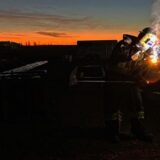Angle Grinder Safety Tips for Industrial Worksites in Saskatchewan
Angle grinder safety is a vital part of daily operations in construction, metal fabrication, and maintenance environments. These powerful handheld tools are incredibly useful but come with serious risks if not used correctly. At Credence Construction Ltd., where structural steel, repair and maintenance, and industrial services are part of everyday work, prioritizing tool safety is non-negotiable.
This blog outlines key angle grinder safety guidelines adapted from the Saskatchewan Construction Safety Association (SCSA) and supports our ongoing focus on safe work practices across all project sites.
Angle Grinder Safety Risks: What You Need to Know
Angle grinder safety begins with understanding the hazards. These tools operate at very high speeds—often up to 11,000 RPM—making them capable of causing serious injuries if not used properly.
Common hazards include:
- Disc Breakage – Discs rated below the grinder’s RPM can break apart and send sharp fragments flying.
- Kickback – If the disc binds while cutting, it can cause the grinder to jerk back toward the user.
- Flying Debris – Sparks, metal shards, and debris can injure the eyes and face.
- Electric Shock – Damaged cords or improper use in wet areas increases this risk.
One case from the SCSA report highlights a worker who removed the guard to install an oversized grinding stone. The stone’s RPM rating was lower than the tool’s speed. This mismatch caused the stone to shatter, injuring the worker’s leg. The lesson here is clear: always match accessories to the tool’s specifications.
Pre-Use Checks: The First Step in Angle Grinder Safety
Angle grinder safety starts before the tool is even turned on. A visual inspection is the first and most basic step. Here’s what to look for:
- Ensure the guard is in place and not damaged.
- Check that the side handle is secure.
- Confirm the grinding disc is the right type and in good condition (no cracks or warping).
- Inspect the cord for cuts or exposed wiring.
These steps are quick, but they make a significant difference in preventing accidents. As emphasized in our Credence blog, routine checks are key to minimizing downtime and injury.
Personal Protective Equipment (PPE) for Angle Grinder Safety
Angle grinder safety also relies on the operator’s gear. Make sure the following PPE is worn every time:
- Eye Protection – Safety goggles or a face shield to prevent injury from sparks and flying particles.
- Gloves – Cut-resistant gloves help maintain grip and shield the hands.
- Hearing Protection – Grinding can reach noise levels over 100 dB.
- Steel-Toed Boots – Protect feet from falling tools or debris.
- Non-Flammable Clothing – Avoid synthetic materials that could melt if exposed to sparks.
These aren’t optional. They’re essential safety practices on any industrial worksite.
Angle Grinder Safety During Operation
When it comes time to operate the tool, a few basic principles go a long way toward preventing injury.
Always Maintain Control
Angle grinder safety means using both hands to control the tool. Hold it firmly with a secure stance. Let the grinder reach full speed before touching the workpiece, and never apply excessive force. The tool should be doing the work, not your strength.
Use the Right Disc for the Job
Never use a cutting disc for grinding or vice versa. Also, avoid using accessories not approved for your model of grinder. Always check the RPM rating on the disc and ensure it matches or exceeds your grinder’s maximum speed.
Keep the Work Area Safe
- Clamp down your material securely.
- Ensure others are standing at a safe distance.
- Keep the area free from flammable materials, and have a fire extinguisher nearby.
- Avoid grinding near explosive atmospheres or materials.
Each of these actions contributes to a safer work zone and better productivity.
After the Job: Safe Shutdown and Storage
Angle grinder safety doesn’t end when you power off the tool. Always allow the disc to come to a full stop before setting it down. Disconnect it from the power source before changing discs or performing any maintenance.
Store the grinder in a clean, dry place. Make sure discs are kept flat and not exposed to moisture or extreme temperatures, as they can warp or weaken over time.
Training: Keeping Angle Grinder Safety Front of Mind
While equipment checks and PPE are important, training is the foundation of angle grinder safety. Toolbox talks are one of the best ways to regularly remind workers of safety protocols. These short safety discussions, promoted by the SCSA, keep safety topics fresh and allow team members to share real-world insights from the field.
Credence Construction Ltd. conducts toolbox talks routinely. Topics include grinder safety, fall prevention, proper lifting techniques, and more. You can explore the SCSA’s collection of free Toolbox Talks here.
Integrating Safety into Your Work Culture
At Credence Construction Ltd., we believe that safety is not just a checklist—it’s a mindset. We’ve built our business around quality, efficiency, and protection for everyone on the worksite. Our services in structural steel fabrication, industrial scaffolding, and repair and maintenance all follow safety-first standards.
Angle grinder safety fits into our larger commitment to excellence. It’s one of the many areas where careful attention today prevents costly mistakes tomorrow.
Final Thoughts
Angle grinder safety is a shared responsibility across every project site. Workers, supervisors, and business owners must work together to enforce best practices—from pre-use inspections and wearing proper PPE to ongoing safety training.
By applying these tips and staying current with safety resources like the SCSA Toolbox Talks, you’ll help ensure a safe, productive environment for everyone involved.
For more insights into workplace safety, project management, and construction services in Saskatchewan, visit our full blog section.



